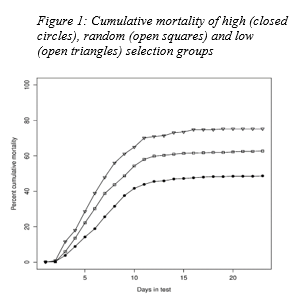ONE GENERATION OF GENOMIC SELECTION IMPROVES WHITE SPOT SYNDROME VIRUS (WSSV) RESISTANCE IN Litopenaeus vannamei SHRIMP
Introduction
White spot syndrome virus (WSSV) is among the most damaging diseases in global shrimp aquaculture regarding production and economic losses (Sánchez-Paz, 2010). Resistance to WSSV in L. vannamei has previously been reported to have low but significant heritability in adult shrimp (Gitterle et al., 2006; Caballero-Zamora et al., 2015) and moderate heritability in juveniles (Trang et al, 2019). Selective breeding is therefore one method that is being used to increase WSSV resistance (Cock et al., 2015). Genomic selection has been predicted to be a powerful and accurate way of selecting among non-infected candidates based on challenge test results from relatives and estimated genomic relationships.
Materials and Methods
Two domesticated shrimp lines were used in this study, known to be resistant (R-line) or susceptible (S-line) for WSSV. Purebred S and R animals as well as crosses between them were produced. From this population 1151 individuals (597 males and 554 females) were used as selection candidates, while 1447 individuals were used as test animals. Selection candidates and test animals were genotyped for 18,643 SNPs to estimate a genomic relationship matrix. The juvenile stage test animals were exposed to a per os infection with WSSV infected tissue in artificial seawater at 30 ppt salinity and 26oC temperature. Genetic parameters and genomic breeding values (Meuwissen et al, 2001) were estimated for survival, and these breeding values were used to select the top 60 high ranking breeding value male and female and the bottom ranking 20 breeding value male and female candidates. These were used to produce 32 resistant and 8 susceptible full sib families. For comparison, 20 random families were produced from candidates not selected for any of these lists. The offspring (1885 individuals) were tagged by family and challenged with WSSV in a controlled test. Mortality of each family was recorded, and genetic parameters were re-estimated in the offspring generation from a sire-dam model, with and without the effect of selection group fitted. For full details on the experiment, see Lillehammer et al., (2020).
Results
Cumulative mortality at the end of the test was 75% in the susceptible, 63% in the random and 49% in the resistant group (Figure 1). The G1 random gEBV group final cumulative mortality during the test was the same as in the G0 training, and the difference between the selection groups was statistically significant. Estimated heritability of WSSV resistance in the offspring was 0.47±0.09, but reduced to 0.41±0.09 if selection groups was accounted for.
Discussion and Conclusion
The large, significant, difference in cumulative mortality between the selection groups demonstrate that genomic selection can be used to increase WSSV resistance. Significant and moderately high (>0.4) heritability of WSSV resistance in the offspring population suggest that repeated selection in future generations will lead to further genetic improvement.
To avoid exposing selection candidates for pathogens, family selection without individual selection is commonly used for disease traits. With genomic selection, individual selection is possible without exposing the breeding candidates to the virus. Thus, with genomic resources selection intensity and genetic gain increases. The SNP genotyping we used was sufficient to obtain genomic breeding values suitable for individual selection. This opens the way to genetic improvement of traits not measured on the breeding candidates.
References
Caballero-Zamora, A., Montaldo, H. H., Campos-Montes, G. R., Cienfuegos-Rivas, E. G., Martínez-Ortega, A., & Castillo-Juárez, H. (2015). Genetic parameters for body weight and survival in the Pacific White Shrimp Penaeus (Litopenaeus) vannamei affected by a White Spot Syndrome Virus (WSSV) natural outbreak. Aquaculture, 447, 102-107. doi:https://doi.org/10.1016/j.aquaculture.2014.08.028
Cock, J., Salazar, M., & Rye, M. (2015). Strategies for managing diseases in non-native shrimp populations. Reviews in Aquaculture, 9(3), 211-226. doi:10.1111/raq.12132
Gitterle, T., Ødegård, J., Gjerde, B., Rye, M., & Salte, R. (2006). Genetic parameters and accuracy of selection for resistance to White Spot Syndrome Virus (WSSV) in Penaeus (Litopenaeus) vannamei using different statistical models. Aquaculture, 251(2), 210-218. doi:https://doi.org/10.1016/j.aquaculture.2005.06.008
Lillehammer, M., Bangera, R., Salazar, M., Vela, S., Erazo, E.C., Suarez, A., Cock, J., Rye, M., & Robinson, N.A. Genomic selection for white spot syndrome virus resistance in whiteleg shrimp boosts survival under an experimental challenge test. Sci Rep. 2020 Nov 25;10(1):20571. doi: 10.1038/s41598-020-77580-3
Meuwissen, T., Hayes, B. & Goddard, M. Prediction of total genetic value using genome-wide dense marker maps. Genetics 157, 1819 - 1829 (2001).
Sánchez-Paz, A. (2010). White spot syndrome virus: an overview on an emergent concern. Vet. Res., 41(6), 43.
Trang, T. T., Hung, N. H., Ninh, N. H., Knibb, W., & Nguyen, N. H. (2019). Genetic Variation in Disease Resistance Against White Spot Syndrome Virus (WSSV) in Liptopenaeus vannamei. Frontiers in genetics, 10, 264-264. doi:10.3389/fgene.2019.00264
